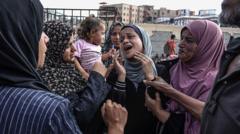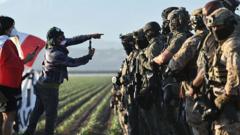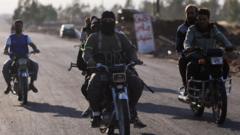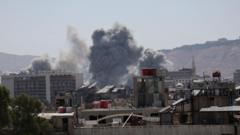The Gaza Health Ministry reports that Israeli forces killed at least 32 people during an attack near an aid distribution site, amid an ongoing humanitarian crisis marked by a controversial new food distribution system backed by Israel.**
Rising Death Toll: Israeli Military Action Claims More Lives in Southern Gaza**

Rising Death Toll: Israeli Military Action Claims More Lives in Southern Gaza**
A recent attack near a food aid site in southern Gaza by Israeli military forces results in the deaths of numerous civilians, raising concerns among aid groups and health authorities.**
The Gaza Health Ministry reported a tragic escalation in violence as Israeli military actions resulted in at least 32 civilian deaths in southern Gaza. This uptick in fatalities occurred on Saturday during an incident near a food aid distribution site, where gunfire from Israeli troops reportedly targeted Palestinian individuals seeking assistance.
The Israeli military has stated that they are investigating these allegations, which has sparked outrage and concern from local news outlets and humanitarian organizations. The main medical facility in southern Gaza, Nasser Medical Complex, confirmed that it received 29 bodies from the scene of the violence without clarifying the circumstances surrounding their deaths or the whereabouts of additional bodies.
This incident is part of a broader pattern of violence associated with Israel’s recently implemented food distribution system, which was introduced approximately two months ago. The United Nations reports that since the new system's rollout in late May, over 670 Palestinians have lost their lives near facilities established under this controversial framework.
Israel’s military has designated the Gaza Humanitarian Foundation — a group supported by Israeli officials and businessmen — to manage food distribution for Palestinians at a limited number of locations in Israeli-controlled territories. This approach supersedes a previous United Nations system that provided food from numerous points, predominantly in regions governed by Hamas.
Israeli officials argue that the updated system is essential to curtail Hamas’s manipulation of humanitarian aid, alleging the group has previously pilfered, stockpiled, and sold food supplies at inflated prices to residents. Conversely, aid organizations contend that this new approach has transformed the quest for food into a perilous daily ordeal, as desperate civilians converge on distribution centers, frequently in close quarters with Israeli military personnel.
Recent months have seen instances where Israeli soldiers fired upon crowds of Palestinians approaching these food sites, raising alarms about the safety of those in search of aid. While Israeli officials have admitted that live fire was used against individuals at the sites, they have also claimed that casualty counts have been exaggerated. The Gaza Humanitarian Foundation asserts that incidents of violence are infrequent at the distribution points and accuses Hamas of instigating unrest while jeopardizing the safety of locals assisting in the operations.
Despite the new distribution framework, aid groups emphasize that widespread food insecurity continues to plague Gaza, exacerbated by an 80-day blockade imposed by Israel earlier this year that restricted access to food and fuel. A report released by the United Nations Relief and Works Agency (UNRWA) this week indicates that during screenings conducted in late June, over 900 of more than 10,600 children assessed displayed clear signs of malnutrition, underscoring the dire humanitarian situation.





















